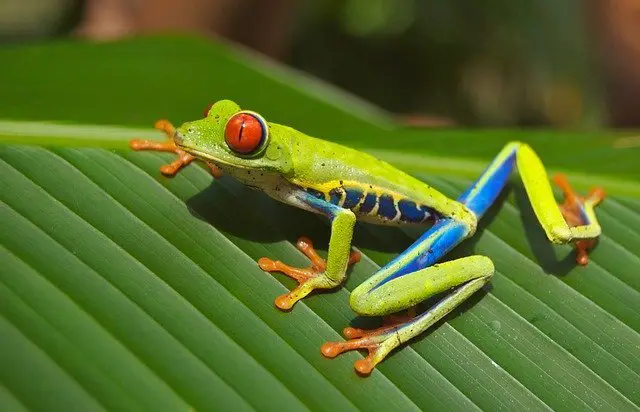Despite their dazzling colors and penchant for camouflage, the red-eyed tree frog is not poisonous and offers no threat to humans.
Where are Red-Eyed Tree Frogs Found?
The red-eyed tree frog (known as Agalychnis callidryas in scientific circles) is found in the mountainous regions of Mexico and Central America. They are prolific creatures and listed as least concerned – meaning their distribution is under no jeopardy of being extinct. The red-eyed tree frog thrives in humid, moist conditions. They are also small in stature and weigh less than one ounce. Typically, the female weighs more than the male.
Trees are the red-eyed tree frog’s favorite location – they blend in perfectly and can keep a panoramic view of the rainforest floor beneath them. They are also free from predators high up.
Red-Eyed Tree Frogs Look Poisonous – Why Aren’t They?
Simply put, the red-eyed tree frog doesn’t need to be poisonous – its camouflage mastery keeps it safe. Their camouflage skills have been refined over millions and millions of years, and the red-eyed tree frog is a master in its field.
Their bright, dazzling colors cause potential predators to freeze, giving the Agalychnis callidryas a fraction of a second to make a quick getaway. There is no need for the red-eyed tree frog to be poisonous, as it can jump quickly and hide on tall trees for protection. They have perfectly adapted to their surroundings and are sure they use them to their full advantage.
Red-eyed tree frogs facts
Most of the red-eyed tree frog’s time is spent living in trees. Their bright green skin, complete with yellow dots resembling leaf imperfections, seamlessly makes them blend into the foliage. Buying its hind legs in, potential predators are oblivious to the red-eyed tree frog’s presence, and it manages to survive the day unscathed most of the time. Their small size and low weight help keep them agile, fast, and hard to spot – when danger does arise, they can get out of harm’s way in mere seconds.
During the nighttime, the red-eyed tree frog comes out to play. Most predators are either asleep or resting, so it is free to survey the landscape in hopes of a tasty meal. Their preferred diets primarily consist of small insects and sometimes even smaller frogs.
Despite not being poisonous, the red-eyed tree frog’s skin is hardly a delicacy. It contains mild toxins that taste unpleasant to predators and humans alike. If you’re ever in the mountains of Mexico and need a meal, a red-eyed tree frog may not be the tastiest snack – but, in terms of frogs, it may be one of the safer options.
[su_box title=”Our Tree Frog Guide “]Thinking about keeping red-tree tree frogs? Are you a newbie or experienced keeper of these beautiful creatures? Then you have to look at our complete and comprehensive guide to maintaining tree frogs. Just click here to have a look[/su_box]
Are they aggressive?
They also do not bite and are not known to be particularly aggressive to humans. If you’re considering getting one as a pet, you’ve made a wise decision. Although not endangered, the Amazonian rainforests they thrive in are shrinking at an alarming rate. Keeping a red-eyed tree frog in captivity will help preserve its short lifespan – about five years in the wild on average.
Although red-eyed tree frogs are not poisonous or volatile, males can be pretty territorial when it comes to other males. When their space is perceived to be invaded, they will shake the branch they are on quite powerfully, especially for creatures of their size.
This is done to ward off a potential invasion, particularly during mating when males are most aggressive. Mating season almost always occurs near bodies or pools of water, where eggs are deposited. The male’s call is answered by the female high up in the trees, and copulation begins. It takes a while for the red-eyed tree frog to reach maturity, and most are ready to reproduce after only two to three years.
If you’ve decided to bite the proverbial bullet and get a red-eyed tree frog companion, you needn’t worry about getting hurt. If you feed it plenty of insects and give it space, it will not cause any problems in your home. They may resemble some of their more evil contemporaries, but red-eyed tree frogs are merely misunderstood animals.
They are neither dangerous nor volatile and are masters of disguise and escape. It’s a shame they don’t get more credit for their brilliance and are now seen as icons of a landscape much in decline. While their distribution numbers will remain vital for many years, their habitat continues to shrink daily.
While red-eyed tree frogs won’t kill you or even make you seriously ill, it’s probably for the best that if you ever come across one, you sit and admire its colors rather than attempt to eat one. By all accounts, they taste rather nasty – and you’ll be better off looking elsewhere for a bite to eat.




